Barring mechanical contact between the spark plug and piston, just about any randomly selected spark plug will ignite the gasoline and air compressed into an engine’s combustion chamber. Very few spark plugs, however, will continue to perform well under a wide range of engine temperatures, loads and speeds, not to mention lasting well beyond today’s standard replacement interval of 100,000 miles.
SPARK PLUG LIFE
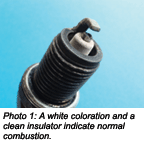 At least four conditions are required for maximum spark plug life. First, the engine management system must mix a chemically perfect or “stoichiometric” ratio of 14.7 units of air to 1 unit of fuel. Second, the combustion event must be perfectly timed to achieve a smooth “burn” in the cylinder. Third, the valve guides, seals, pistons and piston rings must be in good condition to prevent engine oil from entering the combustion chamber. Fourth, the spark plug must be correctly torqued and seated to the cylinder head to help dissipate excess heat from the electrodes. If all of the above conditions are present, the spark plug will have an “out-of-the-box” appearance (See Photo 1).
At least four conditions are required for maximum spark plug life. First, the engine management system must mix a chemically perfect or “stoichiometric” ratio of 14.7 units of air to 1 unit of fuel. Second, the combustion event must be perfectly timed to achieve a smooth “burn” in the cylinder. Third, the valve guides, seals, pistons and piston rings must be in good condition to prevent engine oil from entering the combustion chamber. Fourth, the spark plug must be correctly torqued and seated to the cylinder head to help dissipate excess heat from the electrodes. If all of the above conditions are present, the spark plug will have an “out-of-the-box” appearance (See Photo 1).
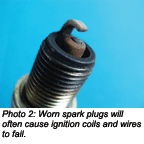 Most spark plugs are designed to maintain an operating temperature of 900° F and 1,500° F at the center insulator. If the insulator temperature drops below 900° F, accumulated carbon causes a cylinder misfire by shorting the spark to ground. During normal driving, the insulator temperature rarely exceeds either temperature extreme and therefore delivers maximum spark plug life. However, as the insulator approaches 1,500° F during wide-open-throttle (WOT) operation, the spark plug electrodes erode until the increased air gap demands more electrical energy than the ignition system can produce to create a spark (See Photo 2).
Most spark plugs are designed to maintain an operating temperature of 900° F and 1,500° F at the center insulator. If the insulator temperature drops below 900° F, accumulated carbon causes a cylinder misfire by shorting the spark to ground. During normal driving, the insulator temperature rarely exceeds either temperature extreme and therefore delivers maximum spark plug life. However, as the insulator approaches 1,500° F during wide-open-throttle (WOT) operation, the spark plug electrodes erode until the increased air gap demands more electrical energy than the ignition system can produce to create a spark (See Photo 2).
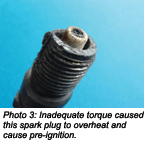 PRE-IGNITION AND DETONATION
PRE-IGNITION AND DETONATION
Although pre-ignition and detonation are rarely encountered on late-model engine management systems, engine damage can occur if the EGR or detonation sensor system has been disabled, the base ignition timing is incorrectly adjusted or an incorrect spark plug heat range is installed.
To illustrate, when the center electrode exceeds 1,500° F temperature, the red-hot electrode will ignite the air/fuel mixture long before the timed spark event takes place. Because pre-ignition exposes the piston to a long-burn event, the center of the piston overheats and will eventually melt. A spark plug exposed to pre-ignition will typically have a salt-and-pepper look, which is caused by bits of melted aluminum sticking to the inner insulator. Pre-ignition is generally caused by over-advanced spark timing or by the heat range of the spark plugs being too hot (See Photo 3). 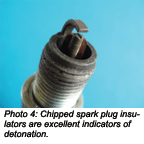 Detonation, on the other hand, is typified by a knocking or rattling sound coming from the engine, which is caused by the nearly simultaneous ignition of the air/fuel mixture at two or more points in the cylinder. Detonation is most often indicated by chipping on the center electrode insulator or breakage of the ring land at the edge of the piston. Although detonation is usually caused by the gasoline’s octane rating not meeting the compression ratio requirements of the engine, detonation can also be caused by an inoperative EGR valve system (See Photo 4). On rare occasions, a longitudinal crack in the center electrode insulator can be caused by a leaking cylinder head gasket allowing coolant to strike the hot insulator (See Photo 5). This should not be confused with damage caused by a detonation condition.
Detonation, on the other hand, is typified by a knocking or rattling sound coming from the engine, which is caused by the nearly simultaneous ignition of the air/fuel mixture at two or more points in the cylinder. Detonation is most often indicated by chipping on the center electrode insulator or breakage of the ring land at the edge of the piston. Although detonation is usually caused by the gasoline’s octane rating not meeting the compression ratio requirements of the engine, detonation can also be caused by an inoperative EGR valve system (See Photo 4). On rare occasions, a longitudinal crack in the center electrode insulator can be caused by a leaking cylinder head gasket allowing coolant to strike the hot insulator (See Photo 5). This should not be confused with damage caused by a detonation condition.
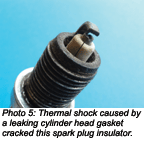 LONG-LIFE SPARK PLUGS
LONG-LIFE SPARK PLUGS
The most common spark plug is made with machined threads cut into an unplated steel shell. These spark plugs are suitable for use only in cast-iron cylinder heads and in applications requiring frequent replacement. Some manufacturers also produce a “truck” spark plug with thicker center and ground electrodes designed to better withstand the erosion caused by prolonged high engine load operation.
The modern long-life plug is made with a very thin plating of oxidation-resistant precious metal on the electrodes and alloy-plated, rolled threads that discourage the thread from seizing in aluminum cylinder heads. In contrast to some OE designs that are plated only on the positive- or negative-firing electrodes, aftermarket “double platinum” replacement spark plugs have both electrodes plated so they can be installed in either positive- or negative-firing cylinders.
In addition, the center electrode on some spark plugs may have a copper core that tends to broaden the heat range of the spark plug. Practically all modern spark plugs incorporate a resistor into the center electrode to prevent radio frequency interference (RFI) from affecting sensitive vehicle electronics. On rare occasion, the firing voltage will increase because the resistor is missing or defective. Resistors can be tested by using a conventional ohmmeter to measure resistance through the spark plug’s center electrode.
In many long-life designs, very thin “wire-type” center electrode diameters are used to enhance the ionization or conductivity of the spark. Most OE ground electrodes are usually welded in place and are of the single- or dual-electrode configurations. In any case, the replacement spark plug should be of the same configuration as the OE to prevent misfires from turning on the check engine light and potentially ruining the catalytic converter on 1996 and newer OBD II engine management systems.
SPARK PLUG HEAT RANGE
The heat range of the spark plug is largely determined by the length of the center electrode’s porcelain insulator. Insulators are very short on racing spark plugs to reduce electrode temperature and prevent pre-ignition on high-compression racing engines. The insulators are relatively long on modern passenger car applications to discourage fouling and to project the electrode deeper into the combustion chamber for more consistent ignition of the air/fuel mixture.
PERFORMANCE APPLICATIONS
Engines modified for increased performance usually require a colder spark plug heat range. Most racing spark plugs, for example, are made in recessed or projected insulator tip configurations. In most cases, the ground electrode is cut back to better expose the center electrode to the air/fuel mixture. While projected-tip spark plugs are preferred, recessed tip plugs may be required to clear high compression pistons.
Generally speaking, the OE spark plug heat range should be reduced one step for each modification that will increase combustion chamber temperature. To illustrate, increasing the compression ratio from 9:1 to 10:1 would require a one-step colder spark plug.
Similarly, adding turbocharging or supercharging would require another one-step colder plug reduction, as would nitrous injection. If the turbocharger or supercharger is operated at extremely high boost pressures for racing applications, an extremely cold racing spark plug would be recommended as a starting point. In any event, each 70-100 hp increase requires a one-step colder heat range to prevent pre-ignition from burning the pistons in the engine.
In general, spark plug readings are best taken by shutting off the engine and coasting to a stop immediately after an extended full-throttle acceleration event. If the spark plug heat range is correct and the engine is operating at a chemically correct or stoichiometric air/fuel ratio, the inner insulator will have an “out-of-the-box” appearance and the ground electrode will be wheat-colored. In general, a correct air/fuel mixture will produce a light tan or grey coloration around the inside of the spark plug shell.
Although reading spark plugs is as much of an art as it is a science, a rule of thumb says that, if the air/fuel mixture is too lean, the inner shell and insulator will look box-clean and the ground electrode will show a blue coloration. If the air/fuel ratio is operating slightly rich, the inner insulator should show a light tan or grey color, while the ground electrode and inner shell should also show a darker tan or grey color. If the air/fuel ratio is too rich, the insulator and electrodes will be lightly coated with soot.
SPARK PLUG AIR GAPS
In essence, a wide electrode air gap will increase burn efficiency on conventional production engines. In racing applications, the air gap is often narrowed to increase the ignitability of the air/fuel mixture at high cylinder pressures and engine speeds.
Always remember that increased air gaps require increased firing voltages that may exceed the capacity of the ignition coil to fire the mixture or the ability of the secondary ignition to contain the spark. Remember, too, that decreased gaps slightly advance spark timing while increased gaps slightly retard timing.
SPARK PLUG INSTALLATION
Because late-model ignition systems are typically producing in excess of 60,000 volts, spark plug wires should be handled carefully to prevent tearing or perforation. Since high-voltage wire insulation eventually develops microscopic perforations and open-circuit conductors, most wires should be replaced at the OE-specified interval or at 100,000-mile intervals.
Several rules should be followed when replacing spark plugs. First, allow aluminum cylinder heads to cool before removing the spark plugs. If a spark plug is seized, soak it with penetrating oil and alternately tighten and loosen the plug until it rotates freely.
Next, always torque the spark plugs to specification. Loose spark plugs can cause pre-ignition or can seize in the cylinder head, and over-tightened spark plugs can cause gas leakage between the shell seal and insulator and damage to the threads in the cylinder head.
To prevent greasy fingers from contaminating spark plug insulators, insert the new spark plug into a length of fuel hose for gapping and installation. When adjusting a spark plug’s air gap, avoid inadvertently scraping the precious metal plating from the electrodes.








